Course Summary
|
Featuring four live online sessions
of 90 - 120 minutes each,
this course is for engineers with a good understanding of linear
analysis but who need to progress to nonlinear analysis for design
and assessment.
Many problems facing designers and
engineers are nonlinear in nature, whether it be masonry arch
cracking, buckling of a plate girder system or soil-structure
interaction. While the assumption of linearity is routinely used for
many designs, sometimes a more refined - nonlinear - approach is
justified.
With LUSAS you can
straightforwardly model the various forms of nonlinear behaviour
that can be encountered, and become proficient in using tools and
facilities that are often seen to be the preserve of the experts.
|
|
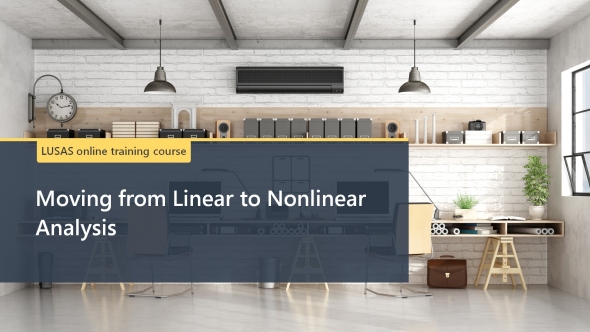
|
|
Obtain answers and practical engineering
guidance to the following:
- Understand why you need to move
from linear to nonlinear analysis
- Appreciate the fundamentals of
nonlinear control and how to obtain a converged solution
- Get an overview of the major
sources of nonlinearity and how to set them up in LUSAS
- Model a staged construction
process that allows the structure to be built and locks in the
stresses from each stage automatically - because most structures
are not "wished in place".
- Learn from practical nonlinear examples
including buckling of a braced
pair of plate girders as a result of a concrete pour, and the assessment of a masonry arch with cracking.
Understand the basics of why
and when you need to do a nonlinear analysis and proceed to cover in
detail:
- Geometric nonlinearity
(including large deflections). How deformations affect the
performance of a structure and its stability or buckling
resilience.
- Nonlinear materials.
Do stresses remain in the linear range? or do you need to
consider yielding, cracking, crushing etc?
- Nonlinear boundary conditions
and contact analysis. When parts of a structure come in or
out of contact, such as how a wind turbine base might interact
with the soil below.
Potential delegates should ensure
they are familiar with linear static analysis using LUSAS prior to
attending this course.
See typical
course content for each session.
|
Course Dates
| Course
name |
Dates |
No
of sessions |
Time
of each session |
Course
cost |
Booking |
| Moving
from Linear to Nonlinear Analysis |
2,
9, 16, 23 May 2024 |
4 |
14:00
- 16:00 BST |
395
GBP |
 |
| Moving
from Linear to Nonlinear Analysis |
10,
17, 24, 31 October 2024 |
4 |
14:00
- 16:00 BST |
395
GBP |
 |
Bookings and payments
-
To book and pay for a single place on
a course click the 'Book now' button. If multiple bookings of
staff from the same organisation are required with payment to be
made via a single invoice, please
contact the training course administrator at training@lusas.com
-
Course costs include
handouts and are quoted in local
currencies and are exclusive of any local government taxes (if
applicable).
-
Please note that when paying by credit card the
amount charged in your currency may differ according to exchange rates and credit
card fees incurred, which are beyond our control.
-
For cancellations to attend a training course that are received in writing
at least 1 day prior to the first session taking place, the
course cost will be refunded.
-
LUSAS reserves the right
to reject bookings and
to cancel or re-schedule courses or individual sessions in the
unlikely event of this being required.
A discount is available for an
invoiced booking of 5 or more delegates from the same organisation.
Please contact your account manager or training@lusas.com
for details.
Online training information
| Sessions
presented using |
Session
length |
After
session offline self-study required |
Training
certificates |
| GoToWebinar |
90 to 120 minutes |
45
to 60 minutes |
Issued
on successful completion |
Notes
-
Training sessions
are provided using the GoToWebinar
web conferencing facility. You can join each training session up to 10 minutes before the scheduled start
time. They will start promptly.
-
Training sessions
are a mix of PowerPoint presentation and live demonstration
of LUSAS.
-
Delegates do
not undertake any hands-on examples during each session, but examples that cover the concepts introduced are provided for download and use by
delegates after each session. These examples will take between 45 and 60
minutes of offline self-study to complete. Email support is available from the
lecturer to assist with these examples if needed.
-
Session
presentations can be downloaded from a training course event page
and printed off if required.
-
Delegates
are able to ask the lecturer
questions during the training session via the chat tool or afterwards via email.
-
Sessions
are recorded and links to recordings will be provided to
delegates to allow viewing if a session is missed.
-
Training
certificates are provided to those who successfully complete the
series of worked examples and pass the quiz set after each
session.
-
Registration
for Session 1 is a requirement to attend all
subsequent sessions.
On successful completion
of the course, and with subsequent experience, delegates should be
able to successfully tackle many types of nonlinear analyses that
are encountered in mainstream structural and bridge engineering.
LUSAS software version
LUSAS version 21 will be used to
present this course and is also required to undertake any offline
homework examples.
Accessing LUSAS
Individuals who wish to attend the
training who do not have access to the required version of the
software may request a
temporary training licence from LUSAS to allow the running of the
software on their personal computers. After
booking your place on the course, please
contact training@lusas.com
to request a licence stating your name and details as asked for on
the booking form.
Downloading LUSAS
LUSAS may be downloaded either as an
ISO file, or as a small startup executable. Use whichever is better or works for
you.
| Options
for downloading LUSAS Version 21
|
| ISO file
|
OR |
Web
installer
|
| Download a
single disk image file containing all installation
components.
Select this option for offline installation on one or more
PCs. |
Download a
small setup executable which allows you to choose those
components that you wish to download and install.
Select this option for online installation on a single PC.
|
|

|

|
Please contact onlinetraining@lusas.com
if you have any questions relating to the licence key sent to you.
Typical Course Content
Session 1 -
Introduction to Nonlinear Analysis
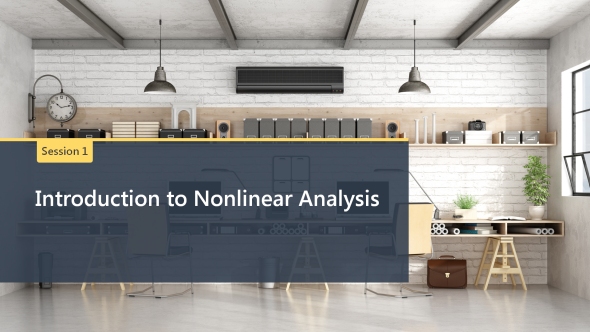 Learn what geometric nonlinearity
actually involves with the use of basic examples not complex theory. The chosen
examples give different outcomes in linear and nonlinear approaches. In many
cases linear and nonlinear analysis gives the same outcome. However there are
many other situations where geometric nonlinearity is simply required to get the
correct answer. Learn what geometric nonlinearity
actually involves with the use of basic examples not complex theory. The chosen
examples give different outcomes in linear and nonlinear approaches. In many
cases linear and nonlinear analysis gives the same outcome. However there are
many other situations where geometric nonlinearity is simply required to get the
correct answer.
-
A simple cable analysis
highlights exactly why geometric nonlinearity is required.
-
Presentation example:
Snap-through of a shallow arch demonstrates geometric nonlinearity,
nonlinear solution strategy and control settings.
-
Homework example: Buckling of a
simplified braced pair of plate girders, to be completed by
delegates.
-
Online quiz to complete the session.
|
Session 2 - Material
nonlinearity
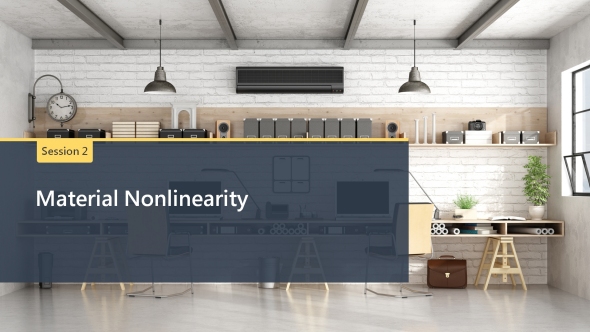 When
engineers think about nonlinear analysis what comes into their head first is
usually material nonlinearity. There are many different aspects of material
nonlinearity and material models include those for elasto-plasticity, brittle
fracture , creep and shrinkage, etc. This session provides an overview of the
nonlinear models available, and shows how to set them up in LUSAS. When
engineers think about nonlinear analysis what comes into their head first is
usually material nonlinearity. There are many different aspects of material
nonlinearity and material models include those for elasto-plasticity, brittle
fracture , creep and shrinkage, etc. This session provides an overview of the
nonlinear models available, and shows how to set them up in LUSAS.
-
Use of a simple model to
demonstrate material nonlinearity.
-
Presentation example: Cracking
of a masonry arch structure.
-
Homework example: Adding
yielding material and imperfection to the simple plate girder from session
1, to be completed by
delegates.
-
Online quiz to complete the session.
|
Session 3 –
Nonlinear boundary conditions
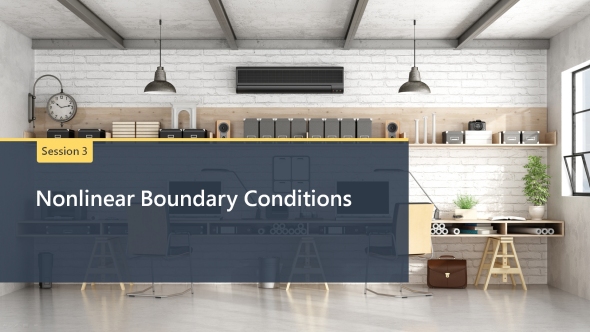 The
last fundamental nonlinear item to consider is contact, with reference to
nonlinear boundary conditions. This could be as simple as a bridge bearing
lifting off a foundation or arbitrary contact between two bodies. This session
will look at simple joint contact as well covering both simple lift-off and
general contact using slideline approach. The
last fundamental nonlinear item to consider is contact, with reference to
nonlinear boundary conditions. This could be as simple as a bridge bearing
lifting off a foundation or arbitrary contact between two bodies. This session
will look at simple joint contact as well covering both simple lift-off and
general contact using slideline approach.
-
Overview of joints and sideline
contact procedures
-
A simple model to demonstrate
changing boundary conditions within loadcases across an analysis.
-
Presentation example: Simple
propped cantilever beam lifting off a support structure with joint contact.
The example will also consider a gap contact procedure.
-
Presentation example: More
general contact example of a circular post base with stiffeners and
slideline boundary conditions.
-
Homework example: Simple propped
cantilever beam lifting off a support structure, modelled with nonlinear
joint boundary conditions, to be completed by
delegates.
-
Online quiz to complete the
session
|
Session 4 – Staged
construction
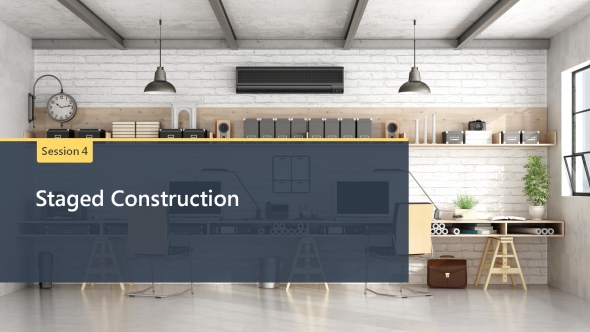 Most
structures are not "wished in place". Engineers follow a detailed
staged construction process that allows the structure to be built. These
intermediate stages affect how the build-up of stresses and forces in the
structure are locked-in and these need to be considered in the final design.
Staged construction is the process of understanding how a structure is to be, or
has been built. Most
structures are not "wished in place". Engineers follow a detailed
staged construction process that allows the structure to be built. These
intermediate stages affect how the build-up of stresses and forces in the
structure are locked-in and these need to be considered in the final design.
Staged construction is the process of understanding how a structure is to be, or
has been built.
-
Overview of staged construction
methods and the activation and deactivation facility
-
Simple models to demonstrate types of staged construction.
-
Presentation examples: cut and
cover tunnel and simple two span beam with creep
-
Homework example: Stage
construction of a simple two span beam with creep, to be completed by
delegates.
-
Online quiz to complete the session.
|
|